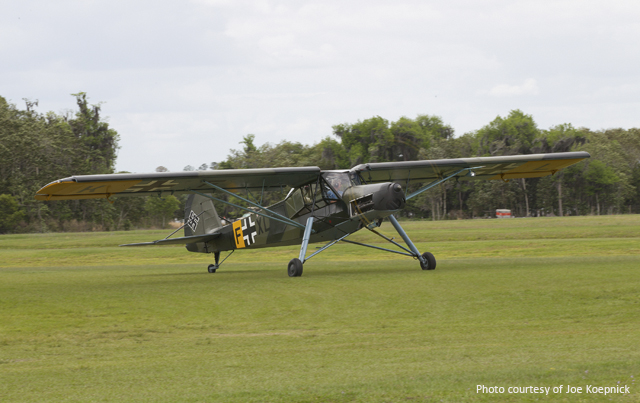
1937 Fieseler Fi-156 Storch
Storch means “stork” in English. This aircraft was designed by Fieseler in 1935 as a slow flying liaison aircraft. With its high-lift wings and fixed slots, it can take-off and land in less than 200 feet and has a stall speed less than 25 mph.
It proved its worth throughout World War II, and over 4000 were ultimately built. Used on all fronts, its engine had a tendency to overheat, and the side cowls were generally left off in hot climates.
This aircraft was involved in many significant events during World War II. Field Marshall Erwin Rommel, “The Desert Fox,” flew in one throughout the North African Campaign, landing in troubled spots everywhere along the front lines. It was a Storch that rescued Italian dictator Mussolini from a hotel atop a mountain peak after Italian partisans captured him toward the end of the war. It was a Storch that transported the bomb that was used in the attempt on Hitler’s life in July of 1944. Less than a year later, during the final days of the war in Europe, famous German female test-pilot Hanna Reitsch flew a Storch into the heart of besieged Berlin. She landed near the Brandenburg Gate to get last minute instructions from Hitler.
Specifications
- Year Built — 1937
- Wingspan — 46’9″
- Speed — 93 mph
- Gross Weight — 2,904 lbs
- Engine — Argus (240 hp)
- Armament — 1 rear-mounted swivel machine gun
Kermit’s Comments
When an aircraft flies slower and slower, the angle of the wing to the air must increase to support the weight of the aircraft. At a certain angle, the air flowing smoothly over the top of the wing will normally become turbulent, and the aircraft will stall. The fixed slot on the front of the Storch’s wing has a larger opening than exit, which allows more and more air to be forced over the top of the wing as its angle increases. This air is accelerated over the top of the wing and allows this wing to fly at a much higher angle before stalling, therefore, allowing a slower speed than normally would be possible. As the flaps are lowered on this aircraft, the ailerons begin to droop down at about half the rate the flaps do. This helps create more lift at slow speed while still allowing the pilot plenty of control.